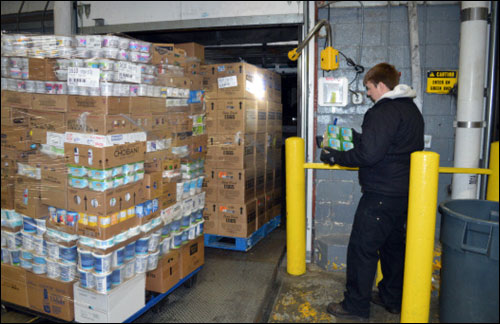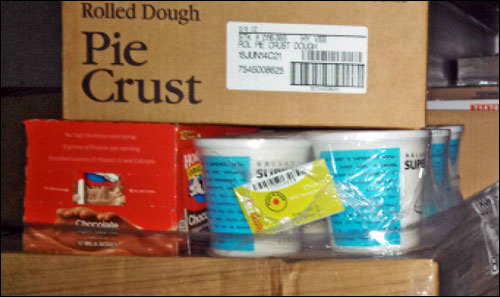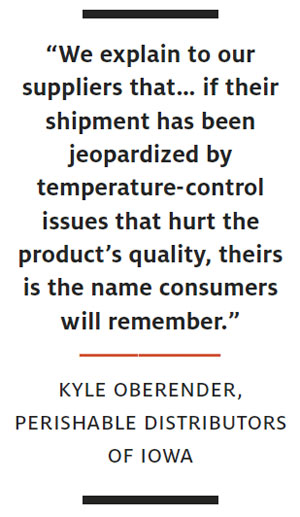Most consumers have had the frustrating and costly experience of finding their milk spoiled or their lettuce wilted before the “use by” date printed on the packaging. That’s because the freshness dates of dairy, produce and other perishable groceries are calculated on the assumption that the item has stayed within appropriate temperature boundaries during its journey from supplier to distribution center to retailer. But it’s not uncommon for perishables to be exposed to significant temperature variations during transit, which can impair product shelf life and quality.
It’s a problem grocery retailers and their distribution arms have been trying to tackle for years. Hy-Vee, a chain of 236 supermarkets in the Midwest, and Perishable Distributors of Iowa (PDI), a wholly owned subsidiary of Hy-Vee, began cold-chain monitoring roughly a decade ago. Some suppliers would attach a single-use digital temperature recorder to each shipment. When the shipment arrived at a PDI distribution center dock door, an employee would take the temperature-tracking device to the warehouse office and download the data from it. PDI developed algorithms based on exposure percentages to automatically determine from the data whether a shipment passed or failed. The system would alert employees if a supervisor needed to be called to investigate whether the shipment should be accepted or refused.

But the hike from any one of PDI’s 54 dock doors to the office to download the shipment’s information could tack five minutes or more onto the receiving process, says Kyle Oberender, PDI’s director of safety. Oberender wanted to streamline the receiving process and take cold-chain monitoring to the next level: tracking the temperature of perishables from PDI DCs to Hy-Vee retail stores.
To accomplish 100 percent cold-chain monitoring using a closed-loop model, Oberender wanted to be able to clear and reset the temperature tags. TempTrip‘s RFID solution met this requirement. “For me,” he says, “RFID is the only solution to be able to do 100 percent monitoring, because the tag can be reused and it can be efficient as well.”
In July 2013, PDI began receiving RFID-tagged perishables at its Hy-Vee DC, in Ankeny, Iowa. Today, roughly 97 percent of dairy, fresh meat and seafood suppliers include one or more TempTrip ultrahigh-frequency RFID tags with each shipment. “Basically, we are running at full speed at the Hy-Vee DC for all fresh items,” Oberender says.
PDI recently RFID-enabled a second, larger DC, in Chariton, Iowa, which is beginning to receive tagged produce, frozen foods, ice cream and other perishables. Hy-Vee in now in the process of RFID-enabling its retail stores.
Getting a Read on the Solution
Oberender had been looking for a reusable temperature recorder. When he learned about TempTrip’s RFID solution, he knew it would accelerate the receiving process, because it would allow employees to download the tag data at the dock door and run the algorithms on the spot. Then, PDI could reconfigure the devices and use them to monitor shipments to the retail stores. “We had been keeping our eye out for a reusable recorder, because we knew the value it would bring,” Oberender says.
PDI first conducted an outbound closed-loop trial in which employees placed TempTrip tags within shipments heading to a retail location. Company drivers retrieved the tags at the point of delivery and returned them to PDI, so the temperature recordings could be uploaded and reviewed. Following this, in May 2013, PDI formed a crossfunctional team to evaluate the solution, with representatives from TempTrip, the DC, and the IT, warehouse, transportation, food safety, purchasing and sales departments.
With the help of a supplier that volunteered to RFID-tag a shipment, PDI tested the receiving and data-integration processes. This trial still used the process of downloading the data at the warehouse office.

TempTrip then tested at its own facilities the setup PDI would use at its site to download the data right at the dock doors. “It worked, so we moved forward on install,” Oberender says. The install included two Impinj Speedway Revolution R420 readers, one at each shipping/receiving dock, and 22 Impinj antennas, approximately one at every other dock door.
Now, when a shipment is received, a dockworker retrieves the TempTrip tag and holds it up to an antenna. The tag data—including ID, temperatures, dates and times—is automatically uploaded to TempTrip’s Web application and Hy-Vee’s server. Each record is associated with other information, including an assigned vendor number, the Department of Transportation number of the carrier that brought the product into the facility, the name of the PDI employee handling the load, and a separate temperature reading taken by thermometer at the point of receipt.
Once the data is uploaded, the algorithms run through an IBM System i server, which reports the pass/fail information back to a Motorola handheld computer. It takes only eight seconds for the data to be uploaded and the tag to be automatically cleared and reconfigured for use.
Hy-Vee suppliers order the tags online at TempTrip’s website. PDI instructs suppliers on tag placement. TempTrip also sends an instructional flyer with every tag order. PDI tracks any “unstarted” tags, so it can follow up individually with any suppliers that may need to retrain their employees.
Typically, each shipment requires one tag. If a shipment includes various items—frozen goods and fresh produce, for instance—each item requires its own tag, to separately track temperatures and enable PDI’s algorithms to appropriately evaluate the loads. “Lunchables items may not have as much exposure allowance as the pickles on the same load, so maybe the pickles pass and can be received but the Lunchables fail and need to be isolated,” Oberender explains.
There have been some challenges in getting suppliers onboard, he notes. Some suppliers already manage a variety of temperature recorders to accommodate different customers, he says, and PDI’s mandate for them to use TempTrip devices adds to their inventory-tracking load. In other cases, suppliers hadn’t been doing any temperature tracking, and this is a completely new expense for them. “We get questions as to why we are doing this or what they will gain from this,” Oberender says. “We explain to our suppliers that their name is associated with the product, and if their shipment has been jeopardized by temperature-control issues that hurt the product’s quality, theirs is the name consumers will remember.”
“Hy-Vee and PDI are investing in the outbound piece,” equipping retail stores with RFID technology to tie the knot on end-to-end cold-chain monitoring, Oberender says. That is the finishing piece that adds visibility and increases control to ensure each supplier’s product consistency, quality and food safety. “So we are asking for them to invest in the in-bound temperature data to the distribution center,” he explains. When necessary, he adds, PDI works out funding issues with its suppliers.

PDI receives more tags than it needs for outbound deliveries to stores, so it has worked out a return-refund arrangement with TempTrip. “TempTrip wants to resell the recorders to suppliers quickly, and there’s no need for us to keep more than we need,” Oberender says.
End-to-End Monitoring
The TempTrip solution has more than met Oberender’s two goals—it speeds receiving processes and allows the temperature tags to be reused to monitor shipments from the DCs to the retail stores. The RFID solution lets PDI decide quickly whether to accept or refuse a shipment. “On the dock at the point of unloading, we can get that data evaluation down from five minutes to eight seconds for the answer of the temp exposure associated with those items we are receiving,” Oberender says.
The RFID data also can be used to improve transport performance. Having access to the data via the TempTrip website is a convenient way to analyze operations, Oberender says. “We can narrow the data by carrier to see the total percentage of exposure to our products in the last six months, for example, and compare which carrier exhibits less temperature abuse,” he says.
In many cases, Hy-Vee uses its own trucks and drivers or contracts with third parties to move products from suppliers to the DCs. PDI can analyze temperature-tracking information to provide insight into the carriers’ performance. “We also are looking forward to managing exposure on the outbound side to let us discover information such as who is the Number 1 driver with the least amount of exposure over a certain period of time,” Oberender says. “And we can set performance measures and possible incentives around managing temperature exposure. I don’t think anyone else has the capability to do that.”
Similarly, if a supplier manages its own transport to a DC and its shipments are refused, particularly if the supplier’s temperature exposure records are unacceptable over time, PDI can provide the vendor with those records. The supplier can then opt to change its carrier partner or take other steps to remedy the problem.
Oberender recalls a case in which PDI received a shipment, from a supplier managing its own transport. The temperature appeared perfectly fine at point of receipt, but the data showed that for approximately one day of the seven-day transport process, the shipment had significant exposure to unacceptable temperatures. At some point, it appeared, the carrier had recognized the problem and gotten the refrigeration back under control for the last couple of days of travel. PDI shared the data with the supplier, which agreed the product should not be accepted.
PDI distribution center workers attach the reconfigured TempTrip tags to shipments they’re trucking to a Hy-Vee store. After delivery, the drivers return the tags to the DC, where the data is uploaded for after-the-fact analysis should a store report a problem with a shipment.
That process is changing, though, as Hy-Vee retailers begin to install RFID infrastructures on site, so they can do real-time evaluations of temperature data at the stores. “We plan to use this as another tool in our current receiving process to evaluate the product upon delivery,” Oberender says. “It’s not as much about accepting or refusing as it is about the green light to continue with confidence. The exceptions of a red light that need to have further attention will now be recognized and investigated, and the product disposition can be made on a case-by-case basis. The biggest benefit to the retailer is that we will be evaluating and managing any and all exposure on both our inbound and our outbound shipments with a goal of zero exposure on both sides. Even the very minor exposures that will not necessarily cause an immediate product issue will be managed unlike any other grocery retailer.”
Hy-Vee RFID-enabled its first two stores in May. Hy-Vee and PDI predict the trial will be successful, and they plan to equip all retail stores before year-end.
Once stores are up and running with the RFID infrastructure, they can leverage their ability to use the RFID readers to assess the temperature exposures of shipments from other sources. “Milk suppliers typically do direct store delivery” rather than going through a PDI distribution center, Oberender says. “Now all the retailer has to do is require the TempTrip tag to be used for milk shipments to get real-time data evaluation at the retail level.”
PDI is also taking steps to monitor more food categories. It’s considering including products that aren’t perishable but are temperature-sensitive—chocolate, for instance. The company is expanding its algorithms to support the new food categories.
Ultimately, a big part of this work is about improving the customer experience, Oberender says: “We want Hy-Vee customers to be able to buy the most stable, consistent, high-quality products.”

